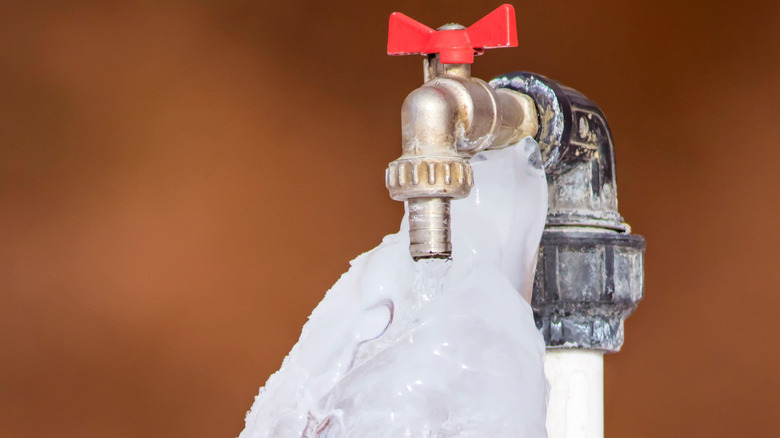Important Tips to Avoid Frozen Pipes in Cold Weather
Important Tips to Avoid Frozen Pipes in Cold Weather
Blog Article
The article author is making several great points on Preventing and dealing with frozen pipes overall in the content in the next paragraphs.
:strip_icc()/snow-outdoor-faucet-pipes-4af65d1e5e904fb1aa7bf74071fe5d89.jpg)
Cold weather can damage your plumbing, particularly by freezing pipes. Here's how to stop it from occurring and what to do if it does.
Intro
As temperature levels decrease, the threat of frozen pipelines rises, potentially causing costly repair services and water damage. Understanding how to avoid frozen pipes is essential for homeowners in cold environments.
Avoidance Tips
Insulating susceptible pipes
Cover pipelines in insulation sleeves or use warmth tape to secure them from freezing temperature levels. Focus on pipelines in unheated or external locations of the home.
Heating strategies
Maintain indoor areas adequately heated up, specifically locations with plumbing. Open up cupboard doors to allow cozy air to circulate around pipelines under sinks.
Exactly how to recognize icy pipelines
Look for lowered water circulation from faucets, unusual odors or sounds from pipes, and visible frost on revealed pipes.
Long-Term Solutions
Structural modifications
Consider rerouting pipelines far from outside walls or unheated locations. Add added insulation to attics, cellars, and crawl spaces.
Upgrading insulation
Purchase high-grade insulation for pipelines, attics, and walls. Proper insulation assists keep regular temperatures and lowers the threat of frozen pipelines.
Securing Outside Pipes
Garden hoses and exterior faucets
Disconnect and drain yard hose pipes before wintertime. Install frost-proof spigots or cover exterior taps with protected caps.
Recognizing Frozen Pipelines
What triggers pipelines to freeze?
Pipelines ice up when revealed to temperature levels below 32 ° F (0 ° C) for extended durations. As water inside the pipes freezes, it expands, putting pressure on the pipe walls and potentially causing them to burst.
Threats and damages
Frozen pipes can result in water disturbances, property damage, and costly repairs. Burst pipelines can flood homes and cause substantial architectural damages.
Indications of Frozen Water Lines
Recognizing frozen pipes early can prevent them from breaking.
What to Do If Your Pipelines Freeze
Immediate actions to take
If you believe icy pipes, maintain taps open up to alleviate pressure as the ice thaws. Use a hairdryer or towels soaked in warm water to thaw pipes gradually.
Verdict
Preventing icy pipes calls for positive procedures and quick responses. By recognizing the reasons, signs, and safety nets, homeowners can protect their plumbing during cold weather.
5 Ways to Prevent Frozen Pipes
Drain Outdoor Faucets and Disconnect Hoses
First, close the shut-off valve that controls the flow of water in the pipe to your outdoor faucet. Then, head outside to disconnect and drain your hose and open the outdoor faucet to allow the water to completely drain out of the line. Turn off the faucet when done. Finally, head back to the shut-off valve and drain the remaining water inside the pipe into a bucket or container. Additionally, if you have a home irrigation system, you should consider hiring an expert to clear the system of water each year.
Insulate Pipes
One of the best and most cost-effective methods for preventing frozen water pipes is to wrap your pipes with insulation. This is especially important for areas in your home that aren’t exposed to heat, such as an attic. We suggest using foam sleeves, which can typically be found at your local hardware store.
Keep Heat Running at 65
Your pipes are located inside your walls, and the temperature there is much colder than the rest of the house. To prevent your pipes from freezing, The Insurance Information Institute suggests that you keep your home heated to at least 65 degrees, even when traveling. You may want to invest in smart devices that can keep an eye on the temperature in your home while you’re away.
Leave Water Dripping
Moving water — even a small trickle — can prevent ice from forming inside your pipes. When freezing temps are imminent, start a drip of water from all faucets that serve exposed pipes. Leaving a few faucets running will also help relieve pressure inside the pipes and help prevent a rupture if the water inside freezes.
Open Cupboard Doors
Warm your kitchen and bathroom pipes by opening cupboards and vanities. You should also leave your interior doors ajar to help warm air circulate evenly throughout your home.

Do you like more info about How to prepare your home plumbing for winter weather? Put feedback below. We'd be delighted to know your ideas about this blog posting. We are looking forward to see you back again in the near future. Are you aware of somebody who is sincerely interested in How To Avoid Freezing Pipes? Feel free to share it. Thanks for being here. Kindly check up our website back soon.
More Details Report this page